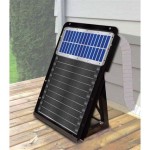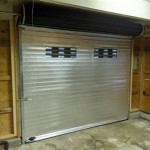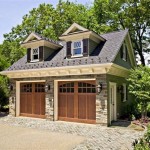How To Keep Your Garage Cool In Texas
Texas summers are notoriously brutal, with temperatures frequently soaring into the triple digits. This intense heat can make working in or even simply entering a garage unbearable. Beyond personal discomfort, excessive heat can damage stored items, compromise the integrity of tools, and even affect the performance of vehicles parked within. Therefore, implementing strategies to mitigate the heat in a Texas garage is not merely a matter of comfort but also a practical necessity.
Several factors contribute to a garage's susceptibility to heat. Garages are often constructed with materials that readily absorb and retain heat, such as concrete and metal. The lack of adequate insulation further exacerbates the problem. Furthermore, garages typically have minimal ventilation, hindering the escape of trapped hot air. The orientation of the garage in relation to the sun also plays a significant role, with south- and west-facing garages receiving the most direct sunlight and, consequently, experiencing the highest temperatures.
Addressing the issue of garage heat in Texas requires a multi-pronged approach, encompassing insulation, ventilation, reflective barriers, and potentially, active cooling solutions. The effectiveness of each strategy will vary depending on the specific characteristics of the garage, the budget available, and the desired level of temperature reduction.
Insulation: A Fundamental Defense Against Heat
Insulation serves as a crucial barrier against heat transfer, slowing the rate at which heat enters the garage from the outside. Insulating the garage door, walls, and ceiling can significantly reduce the overall temperature within the garage. Different types of insulation offer varying levels of thermal resistance, measured by their R-value. Higher R-values indicate better insulation performance.
Garage doors are often a primary source of heat gain, particularly if they are made of metal. Insulating a garage door is a relatively straightforward DIY project that can yield substantial results. Insulation kits specifically designed for garage doors are readily available and typically include pre-cut panels of either polystyrene or polyurethane foam. These panels are attached to the inside of the garage door sections using adhesives or clips. The R-value of these kits typically ranges from R-4 to R-8, depending on the material and thickness.
Insulating garage walls is similar to insulating exterior walls in a home. If the garage walls are unfinished, batt insulation, consisting of fiberglass or mineral wool, can be installed between the studs. The R-value of batt insulation generally ranges from R-13 to R-21 for 2x4 walls and R-30 to R-38 for 2x6 walls. Alternatively, rigid foam board insulation can be applied to the interior or exterior of the walls. Rigid foam board offers higher R-values per inch of thickness than batt insulation and also provides a moisture barrier. Spray foam insulation is another option, offering excellent insulation performance and air sealing capabilities. However, spray foam insulation is typically more expensive and requires professional installation.
Insulating the garage ceiling is particularly important, as heat rises. If the garage has an attic above it, insulating the attic floor is the most effective approach. This can be achieved by laying down loose-fill insulation, such as fiberglass or cellulose, between the ceiling joists. Alternatively, batt insulation can be installed between the joists. The recommended R-value for attic insulation in Texas is typically R-30 to R-60, depending on the climate zone. If the garage ceiling is directly exposed to the roof, insulating the underside of the roof deck is necessary. This can be done using rigid foam board or spray foam insulation.
Ventilation: Allowing Heat to Escape
Proper ventilation is essential for removing hot, stagnant air from the garage and replacing it with cooler, fresh air. Natural ventilation, achieved through strategically placed vents or windows, can be effective in some situations. However, in Texas's intense heat, mechanical ventilation, such as fans or exhaust systems, is often necessary to achieve significant temperature reduction.
Installing vents in the garage walls or roof allows for natural air circulation. High-mounted vents allow hot air to escape, while low-mounted vents allow cooler air to enter. The effectiveness of natural ventilation depends on the prevailing wind direction and the size of the vents. Adding a turbine vent on the roof can further enhance natural ventilation by drawing hot air out of the garage as it spins in the wind.
Ceiling fans can help circulate air within the garage, creating a cooling breeze. While ceiling fans do not lower the overall temperature, they can make the space feel more comfortable by promoting evaporation from the skin. Exhaust fans, installed in the wall or ceiling, are more effective at removing hot air from the garage. A through-wall fan will exhaust hot garage air to the outside. A more powerful vent like a gable-mounted exhaust fan can substantially mitigate heat buildup in a garage as well. Choosing the right size of fan is critical for adequate air exchange.
Powered attic ventilators (PAVs), also known as attic fans, are designed to exhaust hot air from attics. While primarily intended for attics, PAVs can also be used in garages, particularly if the garage has an attic space above it. A PAV can significantly reduce the attic temperature, which in turn can help lower the temperature in the garage below. PAVs are typically thermostatically controlled, turning on automatically when the attic temperature reaches a certain threshold.
Reflective Barriers: Deflecting Solar Radiation
Radiant barriers are materials that reflect solar radiation, preventing heat from entering the garage in the first place. These barriers are typically made of aluminum foil or reflective films and are installed on the underside of the roof deck or on the inside of the garage door. Radiant barriers are most effective in reducing heat gain from direct sunlight, making them particularly useful in Texas.
Installing a radiant barrier on the underside of the roof deck can significantly reduce the amount of heat that enters the garage from the sun. The radiant barrier reflects a significant portion of the solar radiation, preventing it from being absorbed by the roof and transferred to the garage below. Radiant barriers are typically installed during the construction phase, but they can also be retrofitted to existing garages. Retrofitting typically involves attaching the radiant barrier to the underside of the roof deck using staples or adhesive.
Applying reflective window film to garage windows can also help reduce heat gain. Window film reduces the amount of solar radiation that enters the garage through the windows, helping to keep the space cooler. Reflective window films are available in various shades and reflectivities, allowing for customization based on individual needs and preferences. Some window films also offer UV protection, which can help prevent fading of stored items.
Painting the exterior of the garage with a light-colored, reflective paint can help reduce heat absorption. Dark-colored surfaces absorb more solar radiation than light-colored surfaces, leading to higher temperatures. Using a light-colored paint, such as white or beige, can reflect a significant portion of the solar radiation, helping to keep the garage cooler. Specialized reflective paints are available that offer even greater solar reflectance.
Ultimately, the success of keeping a garage cool in Texas depends on a combination of the strategies outlined. Addressing insulation, ventilation, and solar radiation are all important factors in reducing heat buildup. For some garages, these measures may be sufficient to achieve a comfortable temperature. However, in extreme cases, active cooling solutions, such as air conditioners or evaporative coolers, may be necessary to provide adequate cooling. Combining multiple approaches is often the most effective strategy for creating a cooler and more comfortable garage environment during the intense Texas summers.

11 Garage Cooling Ideas Options Solutions

How To Keep Garage Cool In Summer Raynor Doors

How To Cool A Garage With Or No Windows

How To Keep A Garage Cool In The Summer 2024 Guide Hvac Com

How To Cool A Garage In Summer Artisan Doorworks

How To Keep A Garage Cool In Arizona Florida Ae

How Can I Keep My Garage Cool During A Middle Georgia Summer

How To Keep A Garage Cool 10 Steps With S Wikihow Life

How To Cool A Garage Fast

6 Ways How To Keep Your Garage Cool This Summer
See Also








